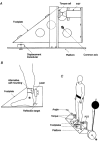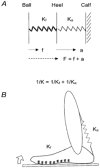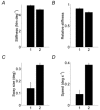Direct measurement of human ankle stiffness during quiet standing: the intrinsic mechanical stiffness is insufficient for stability
- PMID: 12482906
- PMCID: PMC2290720
- DOI: 10.1113/jphysiol.2002.025049
Direct measurement of human ankle stiffness during quiet standing: the intrinsic mechanical stiffness is insufficient for stability
Abstract
During quiet standing the human "inverted pendulum" sways irregularly. In previous work where subjects balanced a real inverted pendulum, we investigated what contribution the intrinsic mechanical ankle stiffness makes to achieve stability. Using the results of a plausible model, we suggested that intrinsic ankle stiffness is inadequate for providing stability. Here, using a piezo-electric translator we applied small, unobtrusive mechanical perturbations to the foot while the subject was standing freely. These short duration perturbations had a similar size and velocity to movements which occur naturally during quiet standing, and they produced no evidence of any stretch reflex response in soleus, or gastrocnemius. Direct measurement confirms our earlier conclusion; intrinsic ankle stiffness is not quite sufficient to stabilise the body or pendulum. On average the directly determined intrinsic stiffness is 91 +/- 23 % (mean +/- S.D.) of that necessary to provide minimal stabilisation. The stiffness was substantially constant, increasing only slightly with ankle torque. This stiffness cannot be neurally regulated in quiet standing. Thus we attribute this stiffness to the foot, Achilles' tendon and aponeurosis rather than the activated calf muscle fibres. Our measurements suggest that the triceps surae muscles maintain balance via a spring-like element which is itself too compliant to guarantee stability. The implication is that the brain cannot set ankle stiffness and then ignore the control task because additional modulation of torque is required to maintain balance. We suggest that the triceps surae muscles maintain balance by predictively controlling the proximal offset of the spring-like element in a ballistic-like manner.
Figures







References
-
- Berthoz A. The Brain's Sense of Movement. Cambridge, MA, USA: Harvard University Press; 2000.
-
- Caron O, Faure B, Breniere Y. Estimating the centre of gravity of the body on the basis of the centre of pressure in standing posture. Journal of Biomechanics. 1997;30:1169–1171. - PubMed
-
- Carpenter MG, Frank JS, Silcher CP. Surface height effects on postural control: a hypothesis for a stiffness strategy for stance. Journal of Vestibular Research. 1999;9:277–286. - PubMed
-
- de Zee M, Voigt M. Moment dependency of the series elastic stiffness in the human plantar flexors measured in vivo. Journal of Biomechanics. 2001;34:1399–1406. - PubMed
-
- Diener HC, Dichgans J, Bootz F, Bacher M. Early stabilization of human posture after a sudden disturbance - Influence of rate and amplitude of displacement. Experimental Brain Research. 1984;56:126–134. - PubMed
Publication types
MeSH terms
LinkOut - more resources
Full Text Sources
Other Literature Sources
Medical

